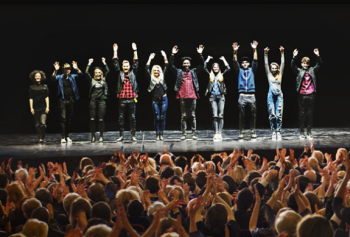
Microphone placement for broadcast and theater present a unique set of challenges compared to miking a concert or studio recording session – not least because traditional placement for optimal sound quality is rarely possible. More often than not, the microphone is required to essentially disappear, as not to hinder the performer or distract from the overall production.
There are a few fundamentals to consider before securing a mic to a performer, because body-worn microphone placement is always a compromise. But our job is to ensure the mic always delivers the same response throughout a performance and on different nights of a production. In this article, I will cover the process I follow to mic performers for vocal reinforcement or recording.
Here are some of the initial questions I ask when setting up a show:
- What is the performer doing?
- What is the overall show? Are we working a rock ‘n’ roll show or an Edwardian period piece?
- What is the design aesthetic?
You might work with the same performers across multiple scenarios, but they’ll likely be giving very different performances. Subsequently, the way we use the microphones will be very different, too. A boom mic is perfectly acceptable aesthetically (and very much required) if you’re working on a show that features an on-stage band. However, if your show is a period play that requires only subtle vocal reinforcement, you won’t want to have a boom mic across the face of every actor.
Production details other than your desired sound will influence your microphone choice fairly early on. For example:
- What are they wearing?
- Do they have wigs, hats, masks, or crazy amounts of hair gel?
All of these elements (and more) will have an impact on mic placement and at what point during the show prep you can fit mics to the performer. It’s a good idea to meet with the costume designer as early as possible, to let them know you’re thinking about mic placement, so you can talk to them about the size and shape of your chosen transmitter. If particular scenes could be a problem for a larger transmitter, the earlier you know, the better – especially if there are budgetary implications.
- How physical is their performance?
- Are they ruffling their hair? Rolling around the stage?
You must consider the physicality of each performance when attaching both the microphone and the transmitter. Crucially, you have to take into account if the mic and body pack will stay put throughout a particularly physical performance.
I firmly believe that good communication is key to a successful, smooth-running show. And while wireless mics are only one part of the sound designer’s palette of tools, it’s an area of sound that impacts many other departments. On a standard day, I will talk to makeup, wardrobe, wigs, performers, stage management, and the sound department to ensure the job gets done.
Consistency is King
With some initial questions answered, let’s now put what we’ve learned into practice with an example scenario. For the purpose of this exercise, let’s assume the performance is not one that requires a boom mic. The brief calls for subtle reinforcement delayed back to the performer’s voice.
Bodyworn mic placement invariably involves some compromise; there are many departments involved, and you can’t please all of them all the time. For this reason, the mic isn’t going to be exactly where your sound designer would choose in an ideal world. To placate the sound team, you must ensure the mic is positioned consistently every time. This way all of your EQ and gain adjustments will also remain consistent throughout.
A centimeter either way in wireless mic terms is a massive difference and can ruin an entire scene. Equally, poor securing of the mic will cause nightmares, too. I worked on My Fair Lady many years ago in the West End. One night, an understudy went on at short notice, leaving little time to double check placement and ensure a secure fit.
Not only did the engineer have to deal with the performer change, but the ear hanger he was wearing flew off during the big dance number. The understudy tried to replace it, but every head flick sent it flying — not fun to mix and not fun for the performer.
Mic Placement Options
On the whole, I prefer all the mics I place to be on the performer’s head, between the temples just forward of the hairline. This position allows the mic to sit on the bone; in my experience, this improves the bass response, giving a rounder sound. I wouldn’t use tape to secure microphones to the face, as this approach is too uncomfortable for the performer to justify any potential improvement.
I tend to secure mics to the performer’s hair using clips. I secure the clips with milliner’s elastic as this gives you some flexibility to move clips as required. The clips come in a few different colors, or you can use spray paint. I would recommend matte spray, as it doesn’t glisten under the lights. I often use a pale clip and then color over the top with stripes of color to match hair types – like a zebra hiding from a lion! I use pens to do this as they’re easier to control, but you might have to redo your work every so often.
Typically, I’ll use three clips: one to secure the mic head and keep it pointing where you want it, one to reinforce this position and one to keep the cable tidy at the back of the head.
The Bottom Line
If you only take one thing away from this article, it should be that clear communication is essential. Speak to as many departments as you can: wigs, wardrobe, performers, makeup, stage-management, lighting. Each department will provide valuable insight into how the show will work.
For example, I recently worked on a show with a false ceiling. As a result, all the lighting came from the sides, which meant that any exposed neck cables had to be securely taped down, so as not to catch the light. By communicating openly with the lighting department, we were able to take the appropriate action in plenty of time to avoid making everyone’s day very stressful.
So, check in with everyone as early as possible, even if it’s just a quick hello and introduction – you’ll be surprised what you find out in a quick informal catch-up. I also find it helpful to chat about how the other departments are working. I like to learn a bit about what the others are doing on a production, so that I understand the constraints and challenges. That way you’re less likely to encounter misunderstandings, and everyone’s job gets easier and more fun.

